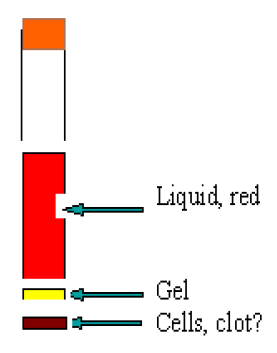4.43: Possible Sample Contamination
- Page ID
- 38707
A technologist working on a chemistry analyzer is reviewing the results of the analysis for a basic metabolic profile; one sample has a very low total calcium of 5.4 mg/dL. The technologist performs a delta check and determines that there has been no previous sample on this patient. The technologist looks at the sample and sees the following.

According to the label on the tube, the tube for this sample was an evacuated phlebotomy tube containing a gel. After a further review of the patient’s laboratory data in the laboratory information system (LIS), the technologist reports the result as a ‘critical value”, but adds the following comment to the result: “Possible contaminating material; send a repeat sample.”
QUESTION
Why did the technologist make this comment?
Questions to Consider
- Is there anything unusual about how the centrifuged sample looked?
- What other types of samples might give this appearance?
- What other information do you think the technologist found in the LIS?
- Answer
-
The technologist was properly concerned that the very low result for total serum calcium was not correct because the sample was either not a serum sample or was grossly contaminated with another fluid. The result was reported, but with a warning to the physician that something was amiss.
Answers to Questions to Consider
- The usual proportion of blood cells to serum, that is, the hematocrit, is approximately 28-40% (see Chapter 3). This sample obviously has a much lower proportion of blood cells, in this case the clot, to serum. There is obviously something different about this sample.
- There are other types of body fluids that might not have the usual proportion of blood cells that might also be drawn in a gel-barrier type of tube. For instance, the laboratory often receives an extravascular body fluid that is being investigated to determine if it is a transudate or exudate (see Chapter 41). Another unusual body fluid could be a synovial fluid (also see Chapter 41). Body fluids usually will contain some blood cells, but usually much fewer than what is associated with a serum sample. While synovial fluid is usually clear but viscous, it may be contaminated with blood. In all these cases, because the sample may contain blood and need to be properly processed to yield a clean sample for analysis, the sample is drawn into the usual serum-separator tube (see chapter 3).
- The technologist first looked up other laboratory data obtained on the day this sample was obtained (see chapter 18). Upon noting that the hematocrit on that day was 35%, the technologist knew that this was probably not a normal blood sample, or if it was, it was grossly contaminated with some other fluid (such as, IV fluid; see chapter 3). The technologist also looked up information on the phlebotomy of this sample, but no explanation could be found.

